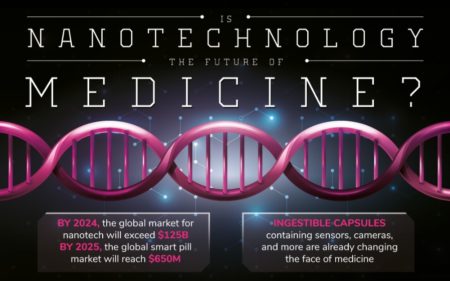October 19, 2019 – What is nanotechnology? It is technology built with parts a mere fraction of the width of a human hair, and it holds great promise for use in a wide number of fields including medicine where it seems to be catching on very quickly creating less invasive ways to diagnose and treat disease.
One of these nanotechnology breakthroughs is a category called smart pills. This technology is being used to detect cancer, diagnose Crohn’s and other inflammatory bowel diseases, detect enlarged veins that restrict the esophagus, and deliver or monitor critically needed medications. Here are just a few examples of this growing field.
The PillCam has fostered an entirely new approach to endoscopy of the small intestine. Using tiny wireless cameras no bigger than a vitamin capsule, doctors receive thousands of pictures of an area of the small intestine that traditional endoscopy procedures can’t easily reach using a tube with an enclosed video camera lens and feed inserted through the rectum or down the throat. With the PillCam, you swallow, it travels through your gut and eventually comes out with a bowel movement and can be flushed away. There is a small risk the capsule could lodge somewhere in the lining of the bowel, but the risks are far less than what can occur in traditional endoscopies.
The Vibrant Capsule is swallowed to treat chronic constipation without the use of chemicals or drugs. It provides mechanical stimulation inducing normal contractions of the large bowel.
Dose tracking pills like the Abilify Mycite can be used to record drug ingestion to ensure a patient is taking critically important medicine.
The Atmo Gas Capsule when swallowed senses oxygen, hydrogen, and carbon dioxide levels in the body’s gut in real time, and provides doctors with an invaluable tool for assessing the microbiome of the intestine.
From doing biopsies, to performing microsurgery, to tiny bots that deliver drugs to a site in the body, or seek out and destroy proteins associated with the spread of some types of cancers, these powerful and tiny tools that can enter our bodies represent a remarkable advance in medical practice.
But that’s not all. Nanotechnology is being used to turn your smartphone into a microscope capable of detecting virus particles in blood samples. And nano patches containing thousands of microneedles are being used to deliver smaller vaccine doses, causing fewer immune reactions. And nanofiber infused hydrogel bandages are being applied to stop bleeding, detect infection, and release antibiotics if needed.
The biggest remaining challenge is to get both medical professional and public acceptance of these nano-inventions. Fortunately, infographics like the one depicted below provide easily digestible information with links for those readers who want to learn more.

















